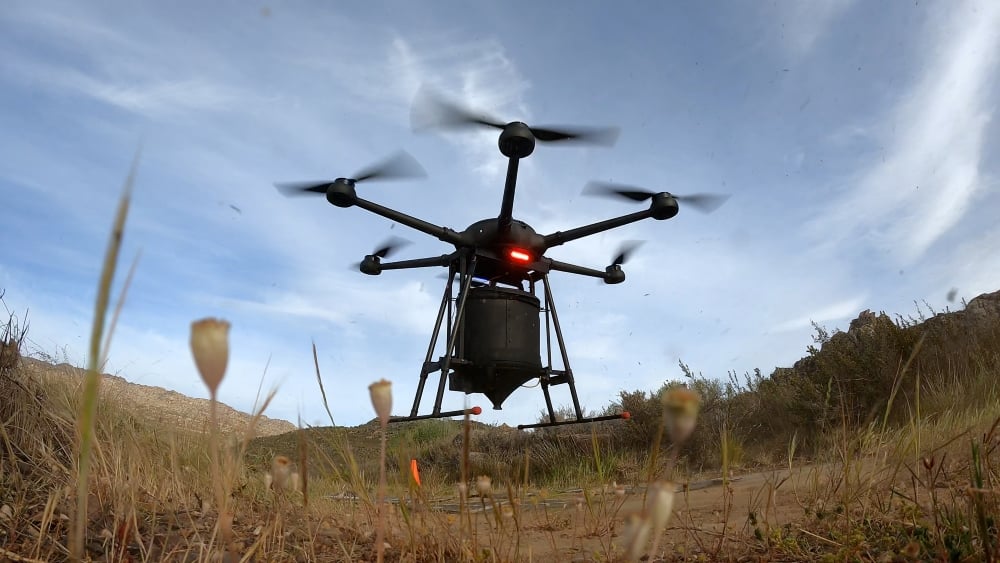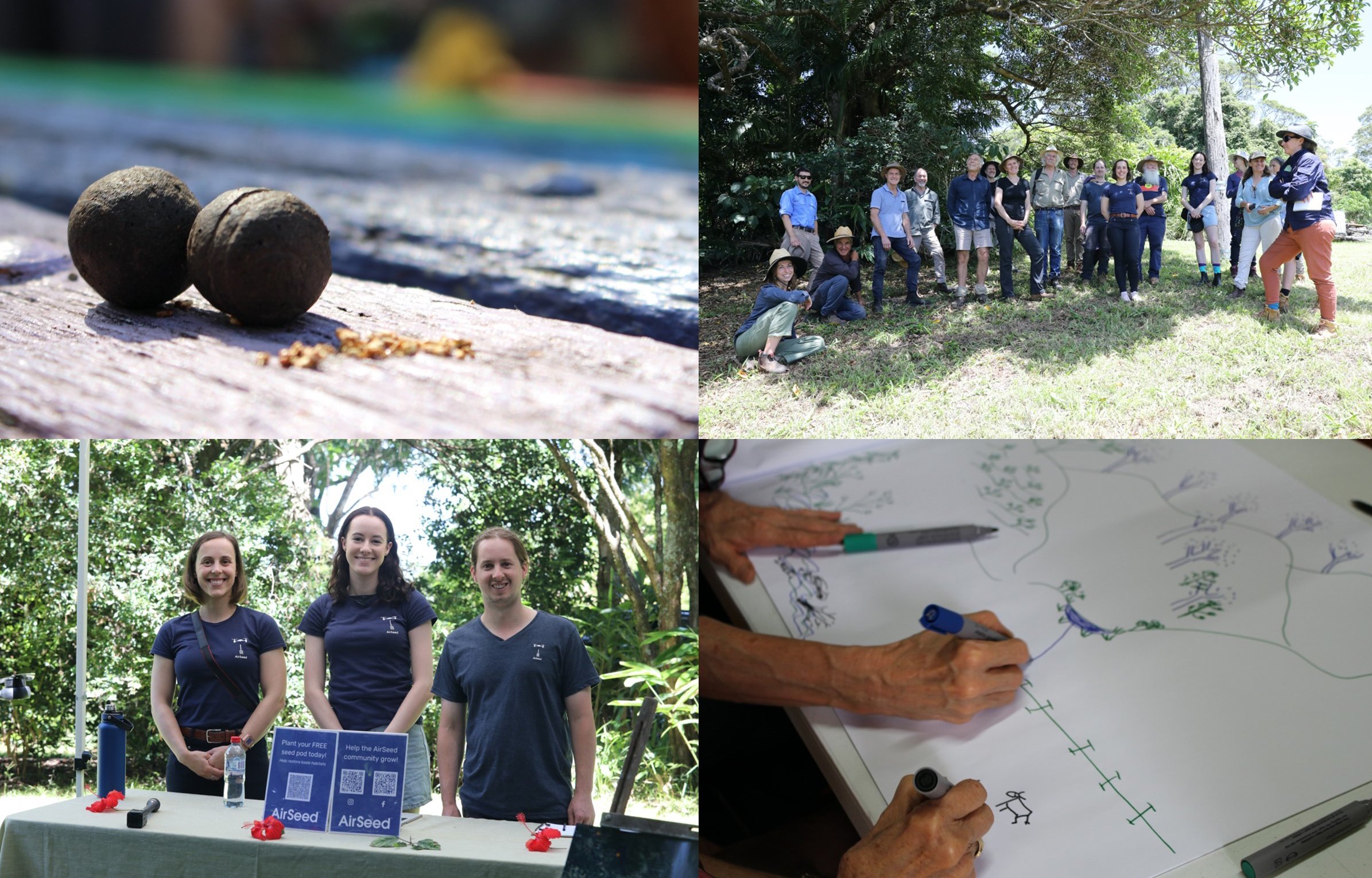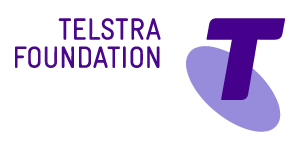
AirSeed: Drone planting takes flight to promote reforestation in flood-affected NSW
AirSeed: Drone planting takes flight to promote reforestation in flood-affected NSW
Organisation: AirSeed Technologies
Innovation Program: Humanitech Lab
Collaborators: Richmond Land Care, Conservation Volunteers Australia, Broader Ranges Landcare and community members impacted by flooding.
- Challenge: Bushfires, flooding, and landslides exacerbated by climate change, are accelerating the rate of biodiversity loss in Australia. Impacted areas require rapid regeneration to support reforestation and ecological resilience.
-
Technology: AirSeed has developed a unique approach to tackle climate change and restore biodiversity by combining drone technology, machine learning, and seed pod biotechnology to carry out planting that’s 25 times faster than traditional hand-planting methods.
-
Project: To validate whether this approach could be delivered in partnership with disaster-affected communities to support local regeneration efforts, AirSeed collaborated with landholders impacted by landslides in northern New South Wales.
-
Impact: 60,000 seed pods were planted across 12 sites in Lismore and Ballina, involving 14 landholders and multiple communities in long-term stewardship and land regeneration activities.

“It’s a wound and it runs deep; a part of me was taken with it.” Lina
Lina and Geoff had a ‘heart sinking moment’ when they discovered that their property and land had been destroyed in a landslide during 2022’s devastating flooding in the Northern Rivers of NSW.
The couple are based 18 kilometres north-west of Lismore. As bush regenerators, they had been nurturing the environment for many years to be a flourishing home to diverse plant species and wildlife.
"It was a few days of sitting with that heart space, feeling quite emotional about it all before understanding why it happened," they said.
Determined to rehabilitate their land to its former glory, the couple made several attempts to restore it on foot. As the ground was steep, rocky and unstable, it was a dangerous process that couldn’t be completed.
Surprisingly, another opportunity emerged: to partner with an environmental restoration company, AirSeed, who were trialling a new approach to regenerate land in the area with the community using technology.

Accelerating global reforestation
AirSeed is a fast-growing restoration and regeneration business addressing the impacts of climate change. Its Australian-engineered planting drones are equipped with machine learning capabilities and a unique ‘seed pod’ biotechnology – small earthy parcels that contain a blend of seeds, soils, nutrients and microbial amendments specifically designed for each project – to rapidly replant large areas of land. There are several reasons why AirSeed’s technique is suitable for reforesting large area over manual planting approaches.
Firstly, it’s more efficient – with drone planting techniques being 25 times faster than traditional hand-planting methods, as well as cheaper and less labour intensive. It can also access regions that are dangerous or inaccessible, such as in disaster-affected regions or harsh terrain. Finally, the seed pods are tailor-made for each project, based on that area’s ecological needs - increasing the likelihood that seedlings will survive and thrive.
The organisation was interested in learning whether its technology could be applied in humanitarian settings to support communities impacted by disaster, such as flooding, landslides or bushfires. It launched a project with the Humanitech Lab, an innovation program led by Australian Red Cross in collaboration with founding partner Telstra Foundation, that’s dedicated to developing technology alongside communities for humanitarian impact.
The project focused on the role of AirSeed’s drone planting to support community’s recovering from flooding in the Northern Rivers, NSW, and how the project might support community wellbeing, ecosystem resilience, and the land-based drivers of flood disasters in the area.

Recovery and rehabilitation: a community-based approach
To begin the collaboration, AirSeed connected with organisations operating in the broader Lismore and Ballina areas, including Richmond Land Care, Conservation Volunteers Australia and Broader Ranges Landcare. Together they held a series of community workshops to meet locals impacted by flood events that may be interested in being involved in the project.
Project lead Jessica Coldrey, a humanitarian engineer, said that Humanitech’s Humanity First principles supported their approach to engagement during these early stages. The principles are being developed to guide the ethical development of technology when addressing humanitarian problems.
“The Humanity First principles are based around the concept of ‘moving at the speed of trust’, and this resonated with me when working on the ground with people in the community,” Jessica said.
After identifying the properties and landholders that would be involved in the project, AirSeed carried out three different visits to the sites supported through Humanitech.
“The first was to visit the damaged properties, speaking to people to understand more about their situation and their vision for restoring their land,” said Jessica.
The second was to run community workshops, where the group made seed pods together, conducted resilience planning, and carried out collaborative drawing to imagine how the landscape might look in 50- or 60-years’ time.
“We didn’t actually plan the third site visit, because the community was so invested that they wanted to put on their own showcase, inviting organisations and governments in the broader region to come along and learn more about our work together.
It was a privilege to be a part of it and feel a lot of hope and buy-in from the community that resulted from the project,” Jessica continued.
Through AirSeed’s Humanitech Lab project, 60,000 seed pods were planted covering 12 sites for 14 landholders.
The AirSeed team is confident that the project demonstrated how their technology can be used in partnership with communities impacted by disaster to assist with rehabilitation, empower them throughout the regeneration process, and support their efforts in long-term land stewardship.
What’s next
Following the success of the project to date, AirSeed is expanding its planting operations, and by working with more flood-impacted landholders, aims to double its impact in the next six months. AirSeed will continue to develop and formalise the humanitarian arm of its business for people and organisations looking to regenerate land following a disaster.
This includes developing new planting patterns that are suitable for land that’s been impacted by extreme weather events, as there might be minimal topsoil, jagged rockfaces or excess debris.
Inspired by the project’s collaboration with communities, AirSeed will also develop a long-term stewardship plan by involving local communities and community organisations in projects to maintain the health of planted species.
For Lina and Geoff, their involvement in this project has instilled optimism in what’s to come.
“Now, imagining the seed pods waking up, we have so much hope for what we can leave for the next generation,” Lina said.
AirSeed Technologies will pilot its solution to regenerate flood-affected land through the Humanitech Lab in 2023.

